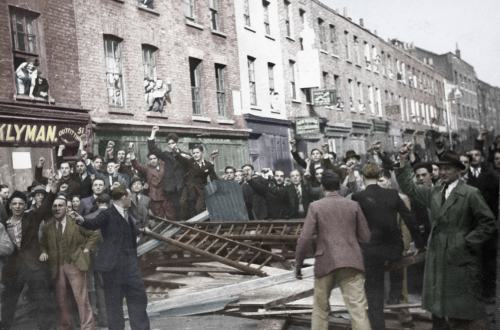This is a cross-post from LGBT Asylum News
By Paul Canning
Update: Alice Murray, director of the Dallas Holocaust Museum, has told Dallas Voice that another gay Holocaust survivor, Gad Beck, is still alive. You can view a film about him here.
Rudolf Brazda, believed to be the last surviving person sent by the Nazis to the death camps for homosexuality, has died aged 98.
He died 3 August, a statement by LSVD Berlin-Brandenburg announced yesterday. The group said that a memorial event would take place for Brazda later today in Berlin.
The group had proposed Brazda be awarded the German Federal Cross of Merit, however it is not awarded posthumously. In April Brazda received France’s top honour Ordre national de la Légion d’honneur (National Order of the Legion of Honour).
Brazda’s life has been documented in the book ‘Das Glück kam immer zu mir‘ (“Happiness always came to me,” which is sort of his motto as he believes he survived through unbroken humor and optimism). Author Alexander Zinn. filmed his research and interviews, as well as Brazda’s shattering return to the Buchenwald concentration camp, for a new documentary, which he hopes should come out this year.
It was only in 2008 that Brazda’s story first came to light. After hearing of the unveiling of the Berlin monument to the ‘pink triangles’, he decided to tell his story. He previously received the gold medals of the cities of Toulouse and Nancy.
In spite of his old age, and health permitting, Brazda was determined to continue speaking out about his past, in the hope that younger generations remain vigilant in the face of present day behaviour and thoughts similar to those which led to the persecutions endured by homosexuals during the Nazi era.
His funeral will be held Monday, 8 August at 10am in Mulhouse, Alsace, France. In accordance with his will, his remains will be cremated and his ashes placed alongside those of his life partner of more than 50 years, Edward Mayer, who died in 2003 in Mulhouse.
Interview with Brazda by Yagg magazine.
The Nazi treatment of gay people first came to light in the late 1970s through the efforts of the very few remaining survivors, especially the play Bent, which was based on the first testimony to be published, in the book the Men with the Pink Triangle.
Bent was made into a film with Clive Owen and Lothaire Bluteau – Trailer:
The directors Rob Epstein and Jeffrey Friedman (who also did The Times of Harvey Milk and ) made the documentary Paragraph 175, the title taken from the German law against homosexuals.
Here’s a trailer:
Speech by Paul Canning
Holocaust Memorial Day, 2007, Cambridge UKWith Germany’s military defeat came liberation of Nazi concentration camps, and the discovery of an unprecedented horror.
For our kind – gays – the nightmare began in 1934, one year after the Nazis came to power, with the creation of the Reich Office for Combating of Homosexuality and Abortion.
767 police-identified or suspected homosexuals were arrested by the Gestapo (State Secret Police), awaiting transfer to concentration camps for “reeducation” at the hands of Hitler’s fanatical SS paramilitary units.
Treatment was brutal; begun without trial, jury, or mercy. The Gestapo tortured gays for information, confessions, names
– and sadistic pleasure.In June 1935 a desperate youth wrote to the only person in authority he trusted: Bishop Ludwig Mueller.
This Berliner – alone, panic stricken – tells the bishop the treatment awaiting gays:
The letter reads:
“[Homosexuals] are tortured for weeks and months on end. Hardly anyone can describe what they do to homosexuals and suspects.
“Not only do they use the foulest language they maltreat them in the most brutal way. Each man has to fall in, stand still and watch 50 to 100 blows rained on a poor creature. The cries and the sight of the flowing blood are terrible.”
The letter closes naively, “People have said that our glorious Fuhrer would punish such acts most severely if they came to his ears. I am of the same view.”
Whether Bishop Mueller had Christian compassion for the plight of gays is not known. There is no record of response from him or of any personal action taken.
German gays – “Varmer bruders” – were worked to death until the war’s end.
The death toll for all inmates was 8 million. It is impossible to estimate how many of them were homosexuals. But estimates range from 430,000 (which is probably too high) to 10,000 (which is probably too low).
Detailed statistical analysis of surviving records indicates that homosexual prisoners were systematically placed in the hardest work commandos (notably the gravel pits at Dachau and the brick works where all of the homosexual inmates of Sachsenhausen worked);
- that the death rate for homosexuals was 50 percent higher than for political prisoners;
- that they received more brutal and more frequent extra punishments than the other prisoners;
- and that they formed the highest percentage of prisoners who were “transported” (the Nazi euphemism for transfer to the gas chambers).
One survivor of Dachau reported: “The inmates with the pink triangles never lived long, they were exterminated by the SS with systematic swiftness.”
By all accounts, hardly any of the homosexual inmates of the concentration camps survived.
The pink triangles were spurned by all other groups in the concentration camps, and many survivors even today refuse to acknowledge the existence of their fellow gay prisoners.
After the war, homosexuals were denied the reparations given by the German government to other groups, because they were still classified as criminals under German law.
They were even denied state pensions to compensate for the amount of time spent in the concentration camps.
They could be re-imprisoned for “repeat offences,” and were kept on the modern lists of “sex offenders.”
The humane institutions of every country have condemned the treatment of all of the victims — except for homosexuals.
On annual days of mourning for the victims, few countries officially mourn for homosexuals.
To the survivor’s comment that “one day they were simply gone” we might add “and today are all but forgotten.”
~~~~~~~~~~~~~~~~
The memorial plaque at Sachsenhausen




